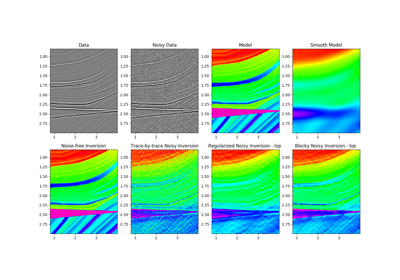pylops.avo.poststack.PoststackLinearModelling¶
-
pylops.avo.poststack.PoststackLinearModelling(wav, nt0, spatdims=None, explicit=False, sparse=False)[source]¶ Post-stack linearized seismic modelling operator.
Create operator to be applied to an acoustic impedance trace (or stack of traces) for generation of band-limited seismic post-stack data. The input model and data have shape \([n_{t0} (\times n_x \times n_y)]\).
Parameters: - wav :
np.ndarray Wavelet in time domain (must had odd number of elements and centered to zero)
- nt0 :
int Number of samples along time axis
- spatdims :
intortuple, optional Number of samples along spatial axis (or axes) (
Noneif only one dimension is available)- explicit :
bool, optional Create a chained linear operator (
False, preferred for large data) or aMatrixMultlinear operator with dense matrix (True, preferred for small data)- sparse :
bool, optional Create a sparse matrix (
True) or dense (False) whenexplicit=True
Returns: - Pop :
LinearOperator post-stack modelling operator.
Notes
Post-stack seismic modelling is the process of constructing seismic post-stack data from a profile of acoustic impedance in time (or depth) domain. This can be easily achieved using the following forward model:
\[d(t, \theta=0) = w(t) * \frac{dln(AI(t))}{dt}\]where \(AI(t)\) is the acoustic impedance profile and \(w(t)\) is the time domain seismic wavelet. In compact form:
\[\mathbf{d}= \mathbf{W} \mathbf{D} \mathbf{ai}\]On the other hand, post-stack inversion aims at recovering the impedance profile from the band-limited seismic stack data.
- wav :
